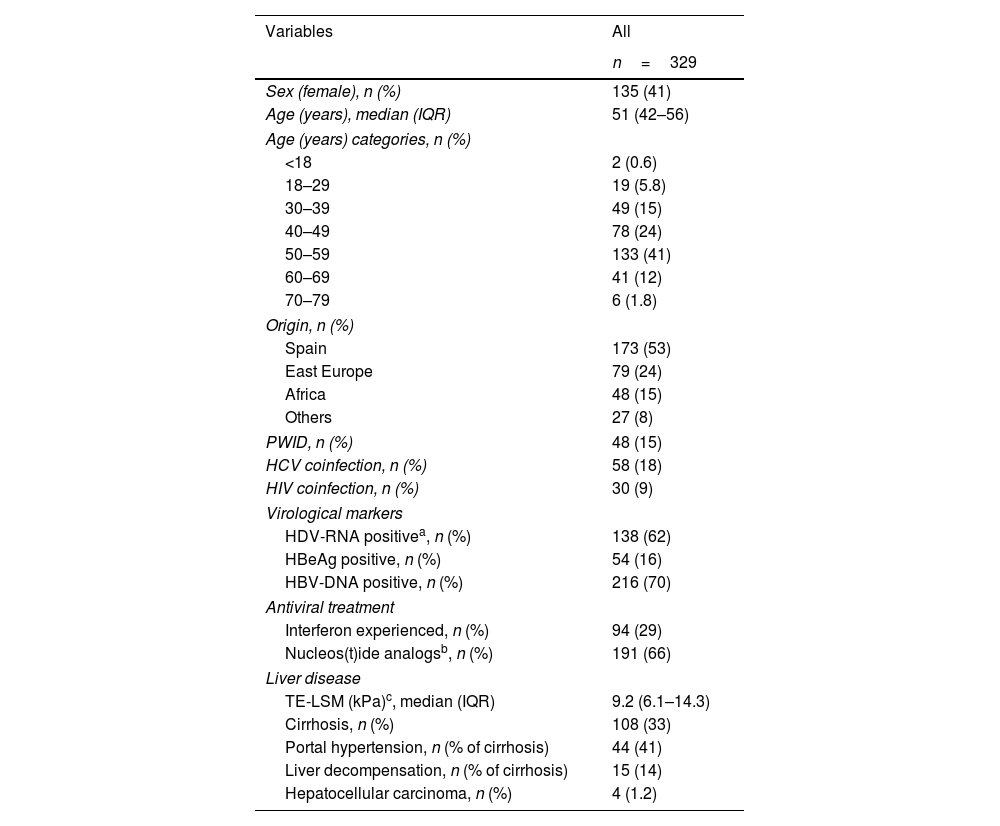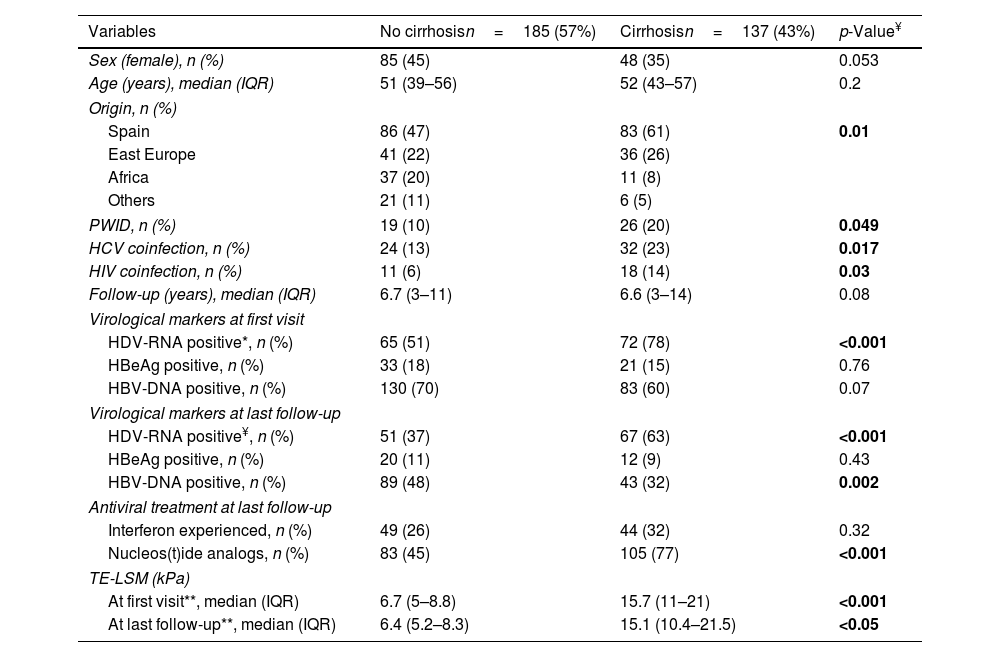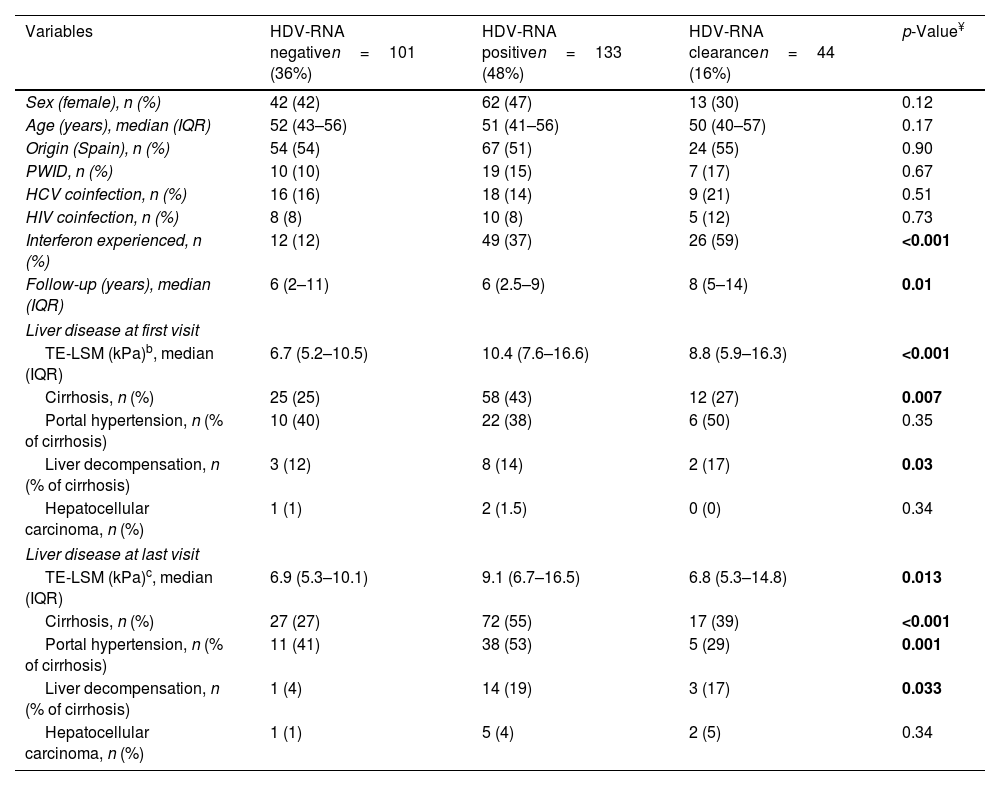Chronic hepatitis D (CHD) is a severe form of chronic viral hepatitis. The estimated hepatitis delta prevalence in Spain is around 5% of patients with hepatitis B. Reimbursement of new antiviral therapies (Bulevirtide, BLV) was delayed in our country until February 2024. We aimed to characterize the clinical profile of patients with HDV/HBV infection in Spain and current barriers in their management at the time of BLV approval.
MethodMulticenter registry including patients with positive anti-HDV serology actively monitored in 30 Spanish centers. Epidemiological, clinical and virological variables were recorded at the start of follow-up and at the last visit.
ResultsWe identified 329 anti-HDV patients, 41% were female with median age 51 years. The most common geographical origin was Spain (53%) and East Europe (24%). Patients from Spain were older and had HCV and HIV coinfection probably associated to past drug injection (p<0.01). HDV-RNA was positive in 138 of 221 assessed (62%). Liver cirrhosis was present at diagnosis in 33% and it was more frequent among viremic patients (58% vs 25%, p<0.01). After a median follow-up of 6 (3–12) years, 44 (16%) resolved infection (18 spontaneously and 26 after Peg-INF). An additional 10% of patients developed cirrhosis (n=137) during follow-up (45% had portal hypertension and 14% liver decompensation). Liver disease progression was associated to persisting viremia.
ConclusionOne-third of the patients with CHD already have cirrhosis at diagnosis. Persistence of positive viremia is associated to rapid liver disease progression. Importantly, barriers to locally determine/quantify HDV-RNA were present.
La hepatitis crónicaD (HCD) es una forma grave de hepatitis viral. Aproximadamente el 5% de los pacientes con hepatitis B en España presentan HCD. La aprobación de bulevirtida (BLV), un antiviral contra el VHD, se retrasó en nuestro país hasta febrero de 2024. Nuestro objetivo fue caracterizar el perfil clínico de los pacientes con infección por HCD en España, así como las barreras existentes en su manejo.
MétodoRegistro multicéntrico que incluye pacientes con serología anti-VHD positiva en seguimiento activo en 30 centros españoles. Se registraron variables epidemiológicas, clínicas y virológicas al inicio del seguimiento y en la última visita.
ResultadosSe identificaron 329 pacientes anti-VHD, el 41% eran mujeres con una mediana de edad de 51años. El origen geográfico más común fue España (53%) y Europa del Este (24%). Los pacientes españoles eran de mayor edad y presentaban coinfección por VHC y VIH, probablemente asociada a consumo de drogas inyectadas (p<0,01). El ARN-VHD fue positivo en 138 de 221 evaluados (62%). Al momento del diagnóstico, el 33% ya tenían cirrosis hepática, y esto fue más frecuente entre los pacientes virémicos (58% vs 25%, p<0,01). Tras una mediana de seguimiento de 6 (3-12) años, 44 (16%) resolvieron la infección (18 de forma espontánea y 26 después de Peg-INF). Un 10% adicional desarrolló cirrosis (n=137) durante el seguimiento (el 45% tenían hipertensión portal y el 14%, descompensación hepática). La progresión de la enfermedad hepática se asoció con la persistencia de la viremia.
ConclusiónUn tercio de los pacientes con HCD ya tienen cirrosis en el momento del diagnóstico. La persistencia de una viremia positiva se asocia con una rápida progresión de la enfermedad hepática. Se detectaron barreras para determinar/cuantificar localmente el ARN-VHD.
Artículo
Comprando el artículo el PDF del mismo podrá ser descargado
Precio 19,34 €
Comprar ahora













